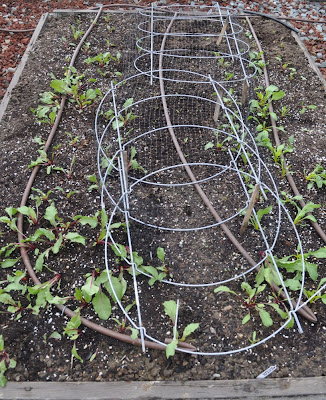They got past immigration. They got got past customs. Heck, they even got past
Hawkeye. These miniature invaders sound innocent enough, related as they are to the relatively harmless though annoying common fruit fly,
Drosophila melanogaster. That four-chromosomed little critter, much favored by geneticists, now has it's nasty cousin visiting it from Asia. They look very similar, except for those unmistakable spots at the tips of the males wings. Unfortunately it looks like the Spotted Wing Drosophila (SWD),
Drosophila suzukii, is here to stay.
Because I like to use my own photos and I don't have any photos of SWD I've set up a link on it's
name that takes you to google images so you can get an idea of what the little terror looks like. For some light relief I've interspersed photographs of current blooms in my garden. So if you don't want to read the sorry tale of the possible demise of cherry growing in home gardens, you can at least purse the pictures. They do not relate to the text at all!
 |
| The first Bird of Paradise of the rainy season have begun to bloom. |
So buckle up - it's time to fly!
Spotted Wing Drosophila was first noted in Hawaii in 1980. In August 2008 it was discovered in strawberries in California. By May 2009 it was infecting Cherries in Gilroy, California. Two years later it has spread as far afield as Florida.
 |
| California fuchsia brightens up a grey day. |
Alternate names for the SWD is the cherry vinegar fly and the cherry drosophila. It differs from the common fruit fly, sometimes called vinegar fly, in
two very subtle ways. First, the males have distinctive dark spots at the tip of each wing. The females do not have spots but are slightly larger than their common (
D. Melanogaster) counterparts.
 |
| Angel wing begonia blossom. |
It is the second difference which causes the most devasting problem. The ovipositor (the thing the female fly lays her eggs with - you can see it in the second page of the
link) has saw-like teeth which can penetrate good fruit, as opposed to damaged or rotten fruit, like the common fruit fly. This means that the healthiest of fruit is at risk, and the SWD actually prefers good fruit rather than dinged or rotten fruit.
 |
| Desert Willow |
The egg is deposited beneath the skin of the fruit where a small hole can be seen. As it grows into a larva, the fruit around the hole becomes mushy and secondary fungal infections may also occur. Also, once SWD had damaged the fruit, its more benign cousin, the fruit fly, will jump in. It grows best at 80F i.e. cherry harvest climate. Santa Clara county has the highest numbers of infestation in California. Doubly devasting as we grow the best and most cherries here.
 |
| Mono lavender |
The generation time for SWD is 12 days - that's the time it takes from the egg is laid until it is a mature adult ready to lay it's own. There are up to 13 generations in a season and the female can lay 300 eggs. It doesn't take a mathematician to work out that that's an awful lot of eggs! In fact, at a recent
Master Gardener talk on the subject a time line was laid out as follows:
June 1st 1 egg laid - gives rise in 2 weeks to :-
June 14th 100 eggs
June 30th 10,000 eggs
July 1st 100,000, 000 (happy 4th of July, hey?)
July 30th 10,000,000,000,000,000
 |
| Coyote bush about to burst into fluffy bloom. |
Cherries are not the only crop at risk. Berries of all kinds and some stone fruit are also under attack. In Oregan there are reports of SWD in grapes and tomatoes - Tomatoes- Yikes! As if there wasn't enough critter out to get them. But so far these fruits have not had any confirmed infestations in California.
 |
| Trumpet flower (I think - Please leave a comment to correct me if I'm wrong.) |
So is there any good news? Not really. There are no biological controls. Mass trapping is ineffective. The egg laying does stop at temperatures below 54F and above 91F. They prefer high humidity and moderate temperatures (70F). The egg and larvae do not survive freezing weather.
 |
| Fuchsia - like little ballerinas. |
So what does it all mean for the organic home grower?
Spinosyn: Spinosad such as Montery Garden Insect spray can be used, though is not as effective as the non-organic organophosphate insecticide malathion, which is highly toxic to bees and other beneficial insects. For more information on integrated pest management checkout the
UC Davis IPM site.
 |
| My first Hollyhocks grown from seed. |
The best (and saddest) recommendation to home growers is, "Do not grow cherries in home gardens."
Bear in mind that as pests go, this one is really new and lots of research into possible natural enemies is still ongoing. It's only been here 2 years so far. That's even less time than I've been here and I still feel new! Let's hope that we find some other bug, fungicide or other beastie that will show the SWD some manners. Then we can get back to only having to pray for enough chill hours for our cherries and then only fight with our feathered friends for the fruit that follows!
Byddi Lee















